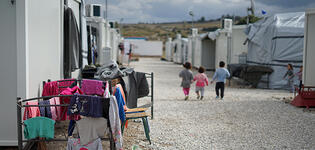Blog
How climate change increases vulnerability to human trafficking in the Philippines
As COP28 unfolds, I share new findings on the impact of climate change on human rights violations and, more specifically, on human trafficking as addressed in Target 8.7 of SDG 8: Decent work. Following extensive community-based field research in the Philippines, the intersection of climate change and human trafficking is getting increasingly clearer.
Recent estimates indicate that 49.6 million people are trafficked worldwide. One’s vulnerability to human trafficking is determined by a host of factors such as conflicts, poverty, and gender inequality. Add climate change to this list.
How climate change can increase human trafficking
On one hand, illegal extractive activities—for example, mining, fishing, and logging in Peru—typically rely on forced and child labour. These activities are often responsible for environmental degradation, including water contamination and deforestation, which exacerbates climate change. On the other hand, the effects of climate change make communities vulnerable. In these circumstances, communities are more exposed to the risk of exploitation.
For eight years, the Philippines has been considered a Tier 1 country in the US Trafficking in Persons (TIP) Report. This designation is certainly a testimony of the Filipino government’s efforts to address human trafficking. However, new challenges promise to deeply affect the human trafficking landscape in the Philippines over the coming years. In order to maintain its Tier 1 status, the government in Manila needs to act promptly and proactively.
Climate change is among the biggest challenges for the Philippines. According to the Global Climate Risk Index, the Philippines ranks 4th on the list of countries most at risk of adverse effects due to climate change. Extreme weather events, such as typhoons and heavy rainfalls, are a common occurrence.
Climate change and vulnerability to exploitation
How does the intersection between climate change and human trafficking play out in the Philippines? To answer this question, we conducted extensive fieldwork in Eastern Visayas and Caraga. In the past decade the severity and frequency of environmental hazards—such as heavy rainfall, floods, droughts, rising temperatures, sea level rise, typhoons, earthquakes, landslides, tsunamis, and tornadoes—has increased in these two regions. These hazards often trigger one another and contribute to an environment characterized by multiple shocks.
The findings from the two selected regions suggest that in communities without adequate pre-disaster preparation strategies and post-disaster recovery mechanisms, climate change-related hazards lead to conditions of multi-dimensional vulnerability. Most notably, it was found that hazard-affected communities are driven into unemployment and poverty, displacement and migration, food insecurity, health insecurity, lack of education, and psychological distress.
Human trafficking in climate change-affected communities
Under these circumstances, communities become exposed to the risk of exploitation by human traffickers. In Eastern Visayas and Caraga, this mostly takes the form of forced labour, (hazardous) child labour, sex trafficking, and online sexual exploitation of children (OSEC).
Forced labour as a result of climate change was observed in a variety of industries in Eastern Visayas and Caraga, including manufacturing, construction, and stream gold mining. According to the informal labourers who were driven into the construction sector by calamities, they were employed ‘for very long hours’, denied contracts, and paid ‘little and irregularly’. They were never provided with protective equipment.
Forced labour as a result of climate change was also observed in the domestic sector, especially when women migrated to Cebu, Manila, or the Gulf monarchies to cope. A survivor of labour trafficking recalled that she moved to Manila after being approached by a recruitment agency with the promise of a good job in the capital. Upon arriving, she found herself in a situation of domestic servitude, imprisoned in her employers’ house and deprived of any means of communication with the outside world. The mother of a migrant domestic worker similarly reported the ordeal of her daughter, who migrated to Saudi Arabia following a typhoon, only to find herself in a prison-like condition.
Child labour, including hazardous child labour, is also prevalent after natural disasters. In the two regions at the center of our research, child labour was observed in mining, construction, forestry, and manufacturing. In these sectors, children are employed for long hours, paid little, and exposed to hazardous conditions.
Cases of child labour are hardly ever reported. Due to a spirit of community support locally known as bayanihan that is especially prevalent in times of hardship, such as after a calamity, most cases of child labour in Eastern Visayas and Caraga tend to be accepted by community members as an inevitable coping strategy, and are not reported to the relevant authorities.
Similar to child labour, the online sexual exploitation of children is not uncommon among impoverished families and extreme weather events are also linked to
an increase in sex trafficking. Most typically, sex trafficking involves women from poor farming families who relocate to urban areas, lured by traffickers with false promises of decent and legitimate jobs.
The path ahead
Recognizing that climate change heightens the vulnerability of individuals and communities to exploitation by human traffickers, actions that address climate change-related vulnerabilities become a much-needed strategy to end the conditions that allow trafficking in persons to exist.
The Filipino government should devote more resources to building the capacity of local communities to prepare for climate change promptly and effectively across different sectors (e.g., healthcare, economy, education). Following climate change-related extreme weather events, the government should improve the quantity and quality of assistance (e.g., reconstruction, scholarships for students, healthcare). Distribution should be equitable, timely, adequate, and just.
The government should also embrace a whole-of-government approach, introducing human trafficking considerations in climate change solutions. In other words, it should better address the intersection of SGD 8 and SDG 13: Climate action.
Development NGOs working in the Philippines can support climate-resilience in two ways: skills development in sectors that are unlikely to be affected by climate change and training on climate-smart agricultural practices—a good example appropriate to the Filipino context is beekeeping, which helps mangroves grow into a barrier against floods.
Anti-trafficking NGOs in the Philippines should conduct awareness-raising campaigns on the intersection of human trafficking and climate change. Special attention should be devoted to those more exposed to climate disasters.
Marta Furlan is Research Program Officer at Free the Slaves. She holds a PhD in International Relations from the University of St Andrews. Marta has published extensively on the topics of armed groups’ approach to International Humanitarian Law (IHL) and armed groups-civilians dynamics in conflict-affected areas.
This blog post in based on research done by Free the Slaves and JPIC-IDC. See: M. Furlan, L. Rosado, Human Trafficking and Climate Change in the Philippines: Understanding Intersections and Strengthening Responses in the Philippines (Free the Slaves: Washington D.C., 2023)
The views expressed in this piece are those of the author(s), and do not necessarily reflect the views of the Institute or the United Nations University, nor the programme/project donors.
 Join the network
Join the network







